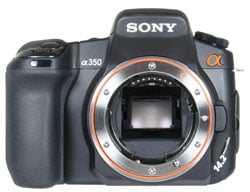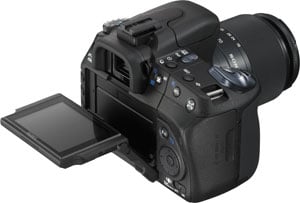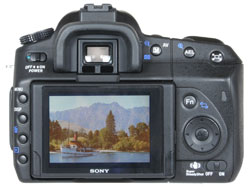Sony Alpha DSLR-A350
-
-
Written by Gordon Laing
Sony Alpha DSLR-A350 Verdict
Sony’s latest DSLRs, the A300 and A350, double the Alpha range and illustrate Sony’s commitment in the market. Indeed by discontinuing the original A100 and introducing four brand new models in as many months, Sony has been more aggressive than any other DSLR manufacturer.
 |
Unlike rival manufacturers, Sony is also interestingly now applying the same strategy to its DSLR range as it has with compacts for years – that is, producing a base model (in this case the A200), then simply adding new, ‘up-selling’ features to subsequent models in the range. So the A300 takes the A200 and adds Live View along with a vertically tiltable monitor. Then the A350 takes the A300 and swaps its 10.2 Megapixel sensor for one with 14.2 Megapixels.
Sony would say this allows buyers to get the exact features they want, but cynics could argue it’s designed to secure greater shelf space in retailers, not to mention provide an easy path for up-selling to the priciest model. Indeed it’ll be interesting to see how well this strategy translates into the DSLR market and whether every retailer – or indeed geographic region – takes all three models.
 |
Marketing strategies aside, what does the latest Alpha really offer? The key selling points are of course the high resolution, built-in stabilisation, tilting screen and Live View facilities.
Starting with the resolution, 14 Megapixels is a lot to pack into an APS-C sensor and Sony’s not managed to change the laws of Physics. As such, keep the A350 at low sensitivities and it’ll capture a great amount of detail, although the modest in-camera sharpening can definitely handle a boost.
As you increase the sensitivity though, the negative impact of noise becomes apparent more quickly than lower resolution DSLRs – although it should be noted Sony’s own 10 Megapixel A200 is no angel in this respect. Sharpening the photos also makes any noise more apparent, so maybe Sony deliberately kept the default image processing on the softer side. The increase in resolution additionally places greater demands on the optics, and the A350 has arguably out-grown the DT 18-70mm kit lens. It’s ok for the money, but to get the most from the A350, you’ll really want to pair it with a better quality lens like the Sony 16-80mm.
In terms of stabilisation, the built-in Super SteadyShot does a great job, offering three stops of compensation in our tests, although you won’t see the effect through the viewfinder – or on-screen during Live View.
Speaking of which, unlike rival DSLRs which use the main sensor to deliver the Live View, Sony’s new Quick AF Live View system employs a small sensor in the viewfinder. A tilting mirror (also in the viewfinder) then directs the light to either the sensor or out through the optical viewfinder.
The major benefit to this system is the traditional AF system isn’t bypassed, so unlike most rivals, the A350 and A300 can autofocus in Live View at exactly the same speed as when composing with the optical viewfinder. There’s also none of the delay or noise as the mirror flips up and down. You can enter and exit Live View quickly and quietly, all while enjoying uncompromised AF performance.
In use it’s surprisingly quick and fuss-free compared to other Live View systems, but isn’t without its downsides. The benefit of rival systems which use their main sensor for delivering Live View is the ability to see exactly what you’re getting: genuine 100% coverage, pixel-perfect magnified manual focus-assistance and a preview of any sensor-shift stabilisation, along with superimposed alignment graphics. Sadly by using a separate sensor in the viewfinder to deliver Live View, the new Sony’s can’t offer any of this. The arrangement also compromises the optical viewfinder performance, which falls in magnification from 0.83x on the A200 to just 0.74x on the A350 and A300. That’s noticeably below other DSLRs.
The fact is though, the lack of mirror noise and image interruption, along with uncompromised auto-focusing speed will see Sony’s Quick AF Live View system preferred by most people, with only technical photographers finding it restrictive. And making Live View even more useful on the A350 is its vertically-tiltable 2.7in screen. Unlike the Panasonic Lumix L10, the Sony screen may not twist horizontally, nor is it able to face the front for self-portraits, but by allowing comfortable shooting over the heads of crowds or at low angles, the most important and useful positions are offered. It’s a great feature.
Other positive features include the friendly Function menu system, on-screen percentage battery meter, the ability to use not only the same battery as the A200, but also its optional grip, and crucially like all Alpha DSLRs, built-in sensor-shift stabilisation which works with any lens you attach.
Downsides beyond those mentioned above, include relatively poor continuous shooting speed, and the absence of mirror lockup and depth of field previews (both of which were on the original A100). Despite these, the A350 remains a highly compelling proposition, so before wrapping-up, how does it compare to the competition?
Compared to Sony Alpha DSLR-A200
We’ll start with the entry-level model in the Alpha range, the DSLR-A200. As explained above, the A200 is effectively the base upon which the A300 and A350 add features. So essentially there isn’t anything the A200 has which the A300 and A350 haven’t – apart from a slightly bigger viewfinder magnification and differently styled grip. The choice between the A200 and the next models up in the Alpha range thend epend on how much you want Live View, the flip-out screen, or more Megapixels. The A300 and A350 both sport Live View and the tilting screen, while the A350 increases the resolution to 14 Megapixels. If however 10 Megapixels are sufficient and you’re not bothered about Live View or a tilting screen, then the Alpha A200 remains a great entry-level DSLR. See our Sony Alpha DSLR-A200 review for more details. |
Compared to Sony Alpha DSLR-A700
With Live View, a tilting screen and a 14 Megapixel sensor, the new A350 appears to trump the existing Alpha flagship, the A700. But in the same way Canon’s budget DSLRs regularly out-resolve their semi-pro counterparts, there’s many more factors to take into account. The A700 is bigger, tougher and faster, boasts 5fps continuous shooting, HDMI output, a bigger viewfinder magnification, and a screen which may not tilt, but is bigger at 3in, and much more detailed with VGA resolution. In the favour of the A350 though are Live View, a tilting screen, lower price, and slightly higher resolution, although this is unlikely to make much difference in real-life. Ultimately higher-end enthusiasts and semi-professional photographers will still prefer the A700, but the A350 certainly gives buyers plenty to weigh-up. See our Sony Alpha DSLR A700 review for more details. |
Compared to Canon EOS 450D / Rebel XSi
Canon’s EOS 450D / Rebel XSi is likely to be the biggest rival to the Sony A350, with both kits costing pretty much the same. The Alpha A350 stands-up very well against the Canon in terms of features, with two extra Megapixels, a tiltable screen, quicker AF in Live View, and built-in stabilisation which works with any lens you attach. And the Sony kit lens is slightly longer too, zooming into 70mm compared to the Canon’s 55mm. In its favour, the Canon 450D / XSi has a slightly bigger 3in screen (albeit fixed in position), quicker 3.5fps continuous shooting, 14-bit image processing, a bigger viewfinder, mirror lockup, a depth-of-field preview button, and a Live View mode which may be slower, but features both a contrast-based AF option and a true preview of what you’ll be capturing from the main sensor. You also get PC remote control software which includes a live on-screen preview. It’s a tough one to weigh-up, but the Alpha A350 arguably has the edge for general buyers while the 450D / XSi will probably appeal to the more technically demanding photographers. See our Canon EOS 450D / Rebel XSi review for more details. |
Compared to Olympus E-510
The Olympus E-510 was one of the most feature-packed DSLRs of 2007 and heavy discounting means it remains one of the best buys in the market. Like the A350, the E-510 has Live View and built-in sensor-shift stabilisation which works on any lens you attach. In its favour, the E-510’s SuperSonic Wave Filter is the best anti-dust system we’ve tested, and while it may not eliminate all foreign particles, it does a great job of making them virtually impossible to see. And while its built-in stabilisation may not be visible through the optical viewfinder, unlike the Sony A350, it can be previewed on-screen. By using the main sensor for Live View, you’ll also see an exact preview of what you’re taking. In its favour, the A350 has quicker AF in Live View, a tiltable screen which is also bigger at 2.7in, four extra Megapixels, and a slightly longer 18-70mm kit lens. But while the E-510 may be out-featured in these respects, there’s no arguing with its bargain price, especially with the twin lens kit which simply offers remarkable value right now. See our Olympus E-510 review for more details. |
Other models to consider
There’s only so many comparisons we have room for on this page, but other models worth considering are Panasonic’s Lumix L10, the Nikon D60 and Nikon D80, and the Pentax K200D and K20D.
Sony Alpha DSLR-A350 final verdict
The Sony Alpha A350 is a feature-packed DSLR with a compelling price tag. With high resolution, built-in stabilisation, Live View and a flip-out screen, it ticks the boxes of most new DSLR buyers. Sony’s fuss-free Live View is also arguably the best implementation yet for general consumers. It’s quick, quiet and offers uncompromised auto-focusing performance. Sure the coverage and accuracy isn’t the same as systems which use the main sensor, but this will only bother the more technical photographers out there.
 |
In general use the A350 handles very well, and apart from its disappointing continuous shooting speed, it’s a highly enjoyable camera in practice. You find yourself regularly switching between the optical viewfinder and Live View with a quick and simple switch, and exploiting the tilting screen for unusual angles.
Like the A200 before it, the menus are easy to navigate and the Function presentation provides easy access to the key settings. Meanwhile, the large chunky buttons are easy to operate even when gloved which will be appreciated by pros or anyone shooting in colder conditions.
On the surface, Sony appears to have aced the competition, and for some photographers this will certainly be true. But more demanding technical photographers may find sufficient issues with the A350 to make it a deal breaker. The Live View may be quick and fuss-free, but by not delivering 100% coverage, superimposed gridlines or magnified manual focus assistance, it’s not as useful for precision work like astro or macro photography.
The jump to 14 Megapixels sounds impressive, and indeed it really does deliver the goods at low sensitivities, but as you increase the ISO, noise becomes more apparent than on lower resolution models. To get the most from the A350’s sensor, you should also upgrade the kit lens to something better like the Sony DT 16-80mm.
The relatively small viewfinder will also disappoint those who’ve used other DSLRs, and the continuous shooting speed is hardly suited for capturing fast action sequences. In all these respects, the A350’s arch rival the Canon EOS 450D / XSi is superior, while additionally offering full PC remote control software with live previews.
So when considering the A350 you have to think very carefully about what kind of photographer you are. If you’d find the 2.5fps continuous shooting slow, the viewfinder small, or the Live View system limiting, then you’ll be better off with something else, like the Canon 450D / XSi. But if these don’t bother you – and to be honest, they won’t affect the majority of budget DSLR shoppers – then the Alpha A350 is a great choice.
With its newly updated Alpha range, Sony has really got into its stride. What started as essentially a rebranded DSLR has now become a range of four compelling models covering entry-level to semi-pro, with promise of a high-end model in the future sporting the company’s 24 Megapixel full-frame sensor.
Despite a few issues which will annoy technical photographers, the Alpha A350 is an excellent DSLR with great features and arguably one of the best Live View implementations to date. Given all it offers for the asking price we can easily award it our Highly Recommended rating. Other manufacturers watch out – Sony means business in the DSLR market.
|
Bad points | Scores (relative to 2008 budget DSLRs) |
 | ||
Build quality: Image quality: Handling: Specification: Value:
Overall: | 17 / 20 18 / 20 18 / 20 18 / 20 17 / 20
88% | |||









